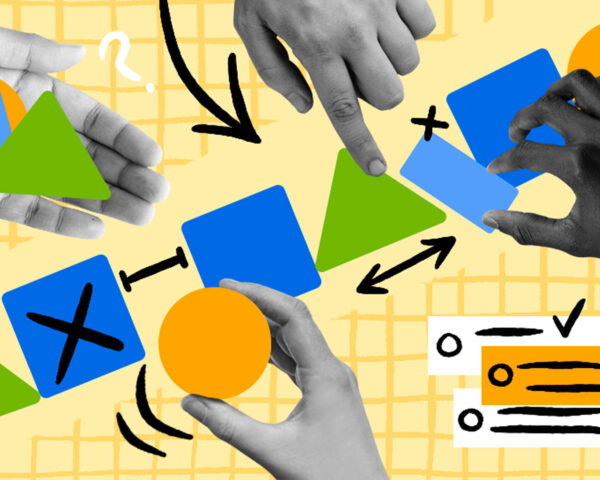5-second summary
- Creating a strong, cohesive team takes intention and planning.
- Researchers have been studying team dynamics for decades. There’s a significant body of knowledge about which organizational structures provide the best results given the circumstances, goals, and personalities involved in a team.
- Here, we’ll share seven classic structures that contribute to strong teamwork, when to use them, and the pros and cons of each.
How do you create, support, and lead a successful team? Any leader will be quick to tell you that there’s a lot that goes into a group that’s efficient, effective, and harmonious. Sometimes teams come together in a surprising mix of personal chemistry. But to truly perform at peak level, teams usually need some formal structure.
Teamwork models can help you make sense of all of it. At first glance, these formal models might sound a little stiff and academic, but most are surprisingly easy to implement. They break down high-performing teams into their core elements, which makes it simpler to account for the different factors that are at play behind the scenes.
Curious? Let’s take a look at seven common teamwork models and talk how you can use them to help your own group navigate around potential pitfalls and do their very best work.
1. The forming-storming-norming-performing-adjourning (FSNPA) model
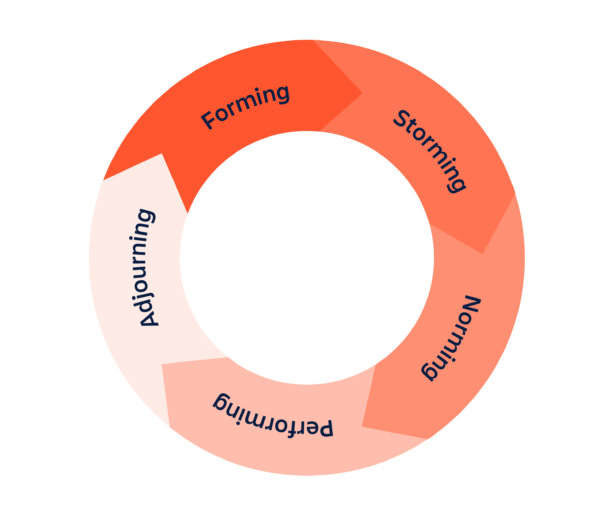
Use it when: You’re forming a brand new team.
If you’ve ever pulled together a team – especially one filled with people who are unfamiliar with each other – you know that you don’t just transform from a group of strangers to a well-oiled machine overnight.
That’s where the FSNPA model comes into play. In 1965, Bruce Tuckman, a psychological researcher, determined that teams move through five distinct stages as they evolve from a collection of individuals to a more cohesive unit:
- Forming: team members come together to meet, iron out their goals, and understand the roles they’ll play on the team.
- Storming: members start to experience some conflict as they learn more about each other’s work and communication styles.
- Norming: with those initial hurdles and hiccups behind them, the team starts to reach a place of more harmony. They better understand each other’s strengths and approaches and fall into a better routine with each other.
- Performing: as the name implies, this is when the magic is really happening. The team is working together well and getting the job done with a clear understanding of each other.
- Adjourning: when the project comes to a close, the team members go their separate ways – but they might participate in a retrospective or some other form of reflection first.
The last stage (adjourning) wasn’t added until later in the 1970s, and for that reason you might also hear this model referred to simply as the “FSNP model.”
Pros of this model:
-Knowing the natural phases of a team makes it far easier to guide your group through the phases of effective collaboration, rather than hoping they figure it out on their own as they go along.
-It allows leaders to easily pinpoint what stage their team is currently in so they can resolve problems or address tension more effectively.
Cons of this model:
-It focuses exclusively on new teams and doesn’t provide much context for long-standing teams who work together continuously (without adjourning) but might have various members coming and going.
-It provides little direction or context about what to do if the team seems to be stuck in a certain stage without moving forward.
2. The Lencioni Model

Use it when: You want to get ahead of potential team problems.
When it comes to leading a team, there’s a lot of emphasis on what you should do. But, the Lencioni model flips that standard approach on its head by spelling out the pitfalls that successful teams need to avoid.
In short, rather than answering “what makes a successful team?” it answers “what doesn’t make a successful team?”
This model was established by Patrick Lencioni, author and expert on organizational health, in his 2005 book The Five Dysfunctions of a Team. Using a pyramid, Lencioni says the following five factors could ultimately lead to a team’s downfall:
- Absence of trust: team members don’t feel that they can be comfortable, honest, and vulnerable with each other.
- Fear of conflict: team members are afraid to rock the boat, so they keep their lips zipped in an effort to maintain harmony.
- Lack of commitment: team members aren’t devoted to the team’s goal and their work together.
- Avoidance of accountability: team members don’t recognize, respect, or appreciate the role they each play in their collaboration.
- Inattention to results: team members lose sight of the bigger picture of what they’re working toward together.
Pros of this model:
-It helps existing teams pinpoint the source of their dysfunction so they can address it.
-It gives leaders an actionable list of pitfalls to avoid when establishing new teams.
Cons of this model:
-It isn’t based on research or empirical evidence, something that several critics have pointed out.
-It doesn’t dig as deep into how leaders can actually address the common dysfunctions.
3. The GRPI Model
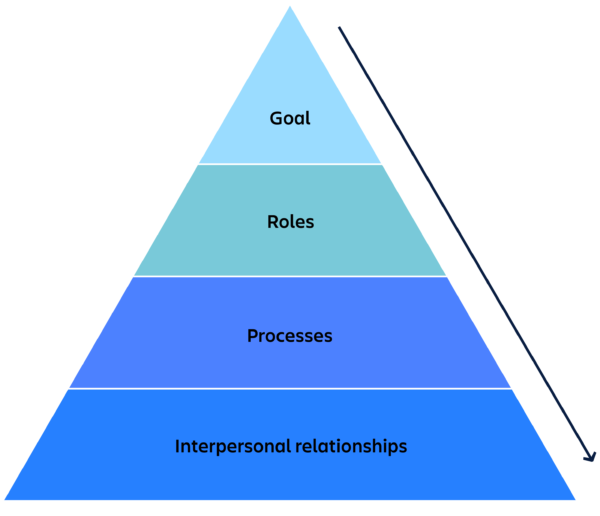
Use it when: You need to understand why your team is underperforming.
Developed by organizational theorist Dick Beckhard in 1972, the GRPI model is another model that focuses on helping leaders understand why their teams might not be achieving peak performance.
When things aren’t going well on your team, it’s tempting to point the finger at interpersonal conflicts. But, as Beckhard’s GRPI model shows, there are a number of other elements that play a role in helping a team be its very best. These include:
- Goals: teams need a solid and shared understanding of what they’re working toward together.
- Roles: teams need to know who’s doing what, without ambiguity or a lot of overlap between responsibilities.
- Processes: teams need to understand how decisions are made and how work gets accomplished.
- Interpersonal relationships: teams need to understand and respect each other’s communication styles and work approaches.
The GRPI model is organized like a pyramid and is designed to move from the top to the bottom as you try to understand where things are going wrong – almost like a checklist.
For example, are your team members aligned on your objectives? Check. Next, does everybody have a clear understanding of their responsibilities? Check. Keep moving down the pyramid.
This model helps leaders and teams uncover the root cause of their issues, rather than defaulting to blaming interpersonal conflicts. After all, that’s the bottom of the pyramid for a reason.
Pros of this model:
-It requires that teams analyze their dysfunction from all sides, rather than making assumptions about where things are falling apart.
-It shifts the attention away from individuals and relationships, which can help reduce tension and promote team cohesion.
Cons of this model:
-It can oversimplify the complexity of interpersonal relationships and the role they play in influencing all of the other factors of the model.
4. The Katzenbach and Smith Model
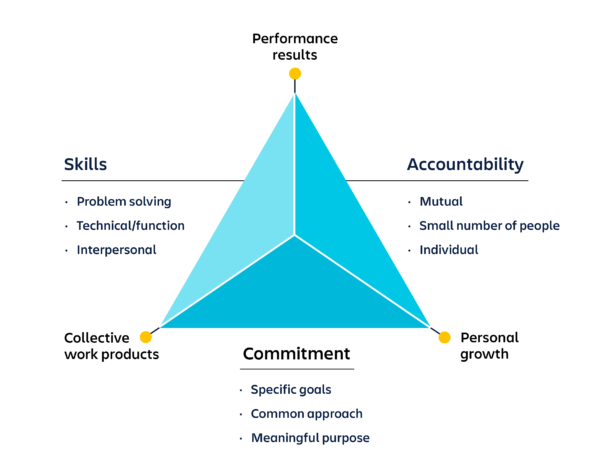
Use it when: Your team is full of individual contributors who are struggling to work together.
Teams come in all shapes and sizes, but generally, they’re all working toward a similar end result.
The Katzenbach and Smith model, which was developed by authors Jon Katzenbach and Douglas Smith in 1993 after they closely studied the work of many teams, states that every team works toward the following large deliverables:
- Collective work products
- Performance results
- Personal growth
But what do they need to get there? Katzenbach and Smith said that teams need the following behaviors in place in order to achieve those deliverables:
- Accountability: teams should have a small enough number of people that both mutual and individual accountability is possible.
- Commitment: teams need specific goals, a sense of purpose, and a shared approach in order to feel fully committed to the work.
- Skills: teams need to have proficient skills in the areas of problem solving, technical capabilities necessary to complete their job duties, and interpersonal relationships.
When those are in place, teams are far more likely to deliver the work, accomplish the intended results, and experience some personal growth along the way.
Pros of this model:
-It’s intuitive, as it focuses on the outputs and what’s needed to achieve them.
-It gives more specific information about each of the effectiveness factors within the pyramid.
Cons of this model:
-It emphasizes the importance of small-sized teams, which isn’t always realistic for organizations.
-It isn’t a diagnostic tool, as it doesn’t help teams understand whether or not they have the necessary factors in place.
5. The T7 Model
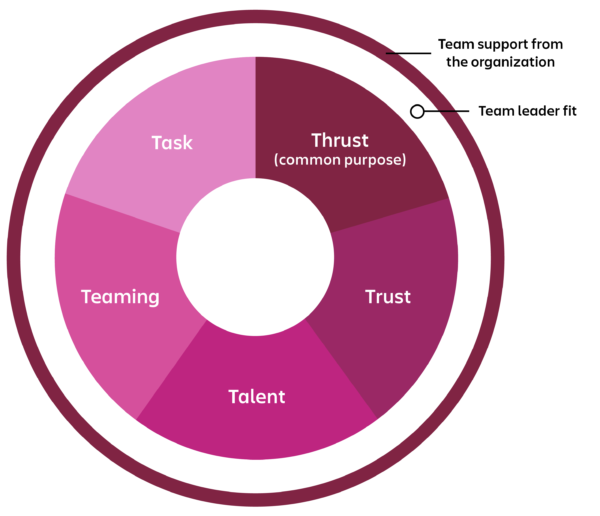
Use it when: You want to understand how your team fits into the bigger picture.
When analyzing and attempting to improve the effectiveness of your team it’s tempting to look at, well, only your team. But the truth is that teams don’t operate in a vacuum and there are other factors that play a role in their ultimate success or demise.
That’s what authors Michael Lombardo and Robert Eichinger spelled out in the T7 model, which they developed in 1995. The model identifies seven different factors for team effectiveness—five that are internal to the team itself and two that are external.
The internal factors are:
- Talent: necessary skills and expertise
- Task: ability to complete the required duties
- Teaming: ability to work together
- Thrust: shared purpose and objective to work toward
- Trust: confidence and faith in other team members
The external factors are:
- Team-leader fit: how well the leader works with the team
- Team support from the organization: how well the organization supports the team
The model is formatted as a circle, which shows that all of the elements need to be in place for ultimate performance. Even if the team has all of the internal factors ironed out, they won’t experience success if the external factors are a problem.
Pros of this model:
-It provides a much broader and more well-rounded view of team effectiveness by looking both inside and outside the team.
Cons of this model:
-It fails to provide information about how to achieve or improve each of the seven factors, particularly external ones that leaders might not have as much control over.
6. The LaFasto and Larson Model
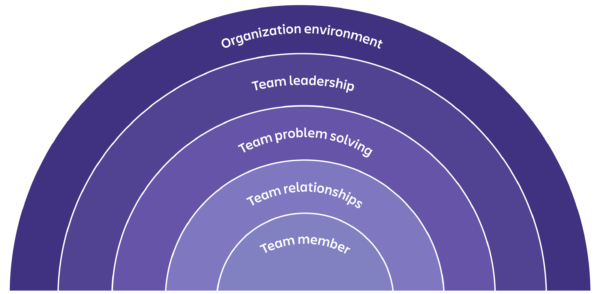
Use it when: You want to understand the individual components of your team.
Authors and business leaders Frank LaFasto and Carl Larson invested a lot of research into the model that they developed in 2001, studying the work of hundreds of team members and leaders to understand what made successful teams tick.
They determined that teams need five dynamics in place, which need to be considered right from the outset when a team is put together. These five elements are:
- Team member: for a team to be successful, it needs to be composed of the right people.
- Team relationships: those individual people need to be able to work well and have productive relationships with each other.
- Team problem solving: teams will need to be focused on their work, openly communicate, and approach problems with a positive attitude.
- Team leadership: the team needs not only the right members, but also the right leader in place.
- Organizational environment: the organization as a whole needs to provide adequate support and resources, rather than creating roadblocks.
The model looks closely at a team from its smallest parts (the team members) all the way up to the environment it functions in.
Pros of this model:
-It’s based on very thorough research and analysis.
-It recognizes that teams can be made up of the most skilled team members, but that alone doesn’t lead to successful outcomes.
Cons of this model:
-It doesn’t provide guidance on how leaders and teams can ensure they have each of the five necessary elements in place.
7. The Hackman Model
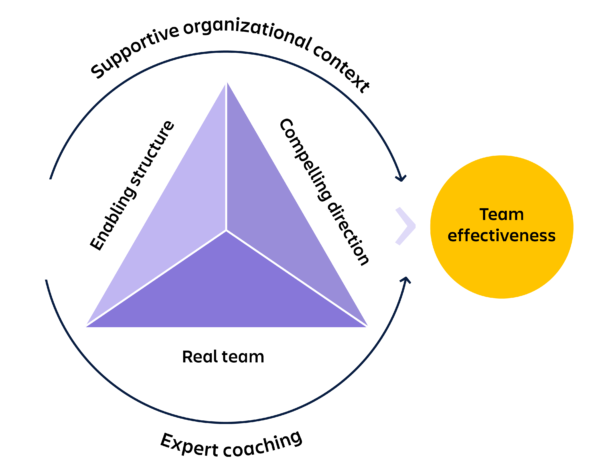
Use it when: You want a clear definition for what “effectiveness” looks like and how to get there.
Researcher, Harvard professor, and expert on teams, Richard Hackman, looked at all sorts of different teams – from musical ensembles to airplane cockpit crews – when developing his model.
In his 2002 book Leading Teams: Setting the Stage for Great Performances, he shared five conditions that need to be present in order for teams to work well together:
- Real team: the team has clear tasks and terms and understands their roles
- Compelling direction: the team has specific goals
- Enabling structure: the team has thoughtful processes and workflows
- Supportive context: the team has access to the resources and information they need
- Expert coaching: the team benefits from leadership, training, and mentoring
Hackman explains that when those five criteria are met, a team is able to reach effectiveness. He even digs into what qualifies a team as “effective,” stating that the team will serve stakeholders well, grow in their capabilities, and find a sense of meaning.
Pros of this model:
-It looks at all aspects of the team, from the individual members to the context the team is operating within.
Cons of this model:
-It doesn’t consider that certain criteria might be more or less motivating for certain teams or team members. For example, individual with different working styles may not always align on processes or workflows.
Use teamwork models to demystify your collaboration
There isn’t one straightforward answer to what makes for a top-notch team, but teamwork models certainly help to expose some of the elements and behaviors that need to be in place.
So, whether you’re forming a brand new team or want to figure out how to better support the one you already have, refer to these frameworks as your roadmap as you plot your way toward peak performance.








































